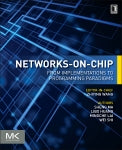Freshly Printed - allow 10 days lead
Couldn't load pickup availability
Networks-on-Chip
From Implementations to Programming Paradigms
Provides a thorough and bottom-up exploration of NoC design
Sheng Ma (Author), Libo Huang (Author), Mingche Lai (Author), Wei Shi (Author), Zhiying Wang (Editor-in-chief)
9780128009796
Paperback / softback, published 8 December 2014
382 pages
23.4 x 19 x 2.4 cm, 0.81 kg
Networks-on-Chip: From Implementations to Programming Paradigms provides a thorough and bottom-up exploration of the whole NoC design space in a coherent and uniform fashion, from low-level router, buffer and topology implementations, to routing and flow control schemes, to co-optimizations of NoC and high-level programming paradigms. This textbook is intended for an advanced course on computer architecture, suitable for graduate students or senior undergrads who want to specialize in the area of computer architecture and Networks-on-Chip. It is also intended for practitioners in the industry in the area of microprocessor design, especially the many-core processor design with a network-on-chip. Graduates can learn many practical and theoretical lessons from this course, and also can be motivated to delve further into the ideas and designs proposed in this book. Industrial engineers can refer to this book to make practical tradeoffs as well. Graduates and engineers who focus on off-chip network design can also refer to this book to achieve deadlock-free routing algorithm designs.
1 Introduction Part One: Logic Implementations 2 A Single-cycle Router with Wing Channel 3 Dynamic VC Routers with Congestion Awareness 4 A NoC Topology with Virtual Bus Part Two: Routing and Flow Control 5 Routing Algorithms for Workload Consolidation 6 Flow Control for Fully Adaptive Routing 7 Deadlock-free Flow Control for Torus NoCs 8 Delay Analysis based on the M/G/1/N Queuing Model Part Three: Programming Paradigms 9 Support Cache-coherent Collective Communication 10 Optimizations to Exploit Communication Locality 11 Customizations for MPI Primitives 12 Conclusions and Future Work
Subject Areas: Computer architecture & logic design [UYF], Circuits & components [TJFC]


